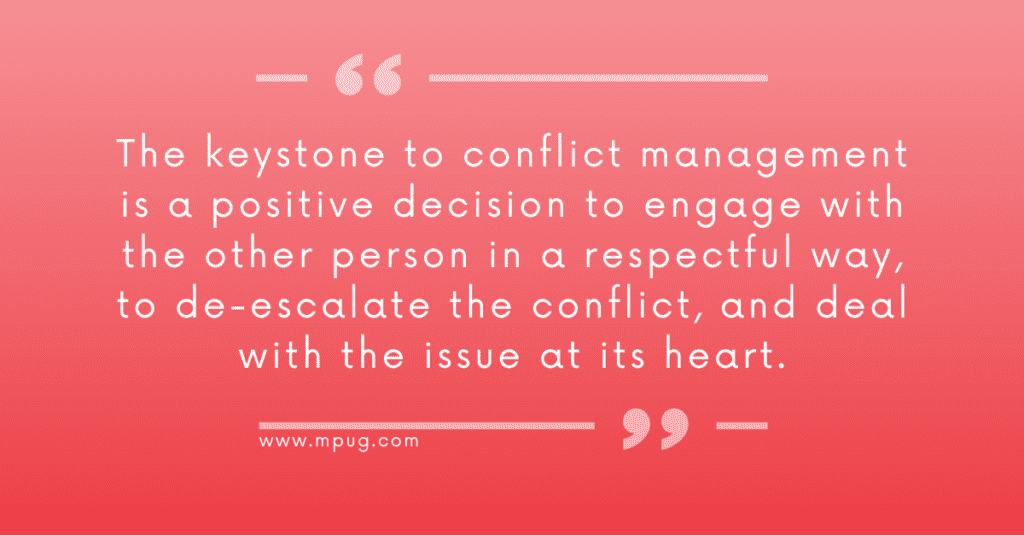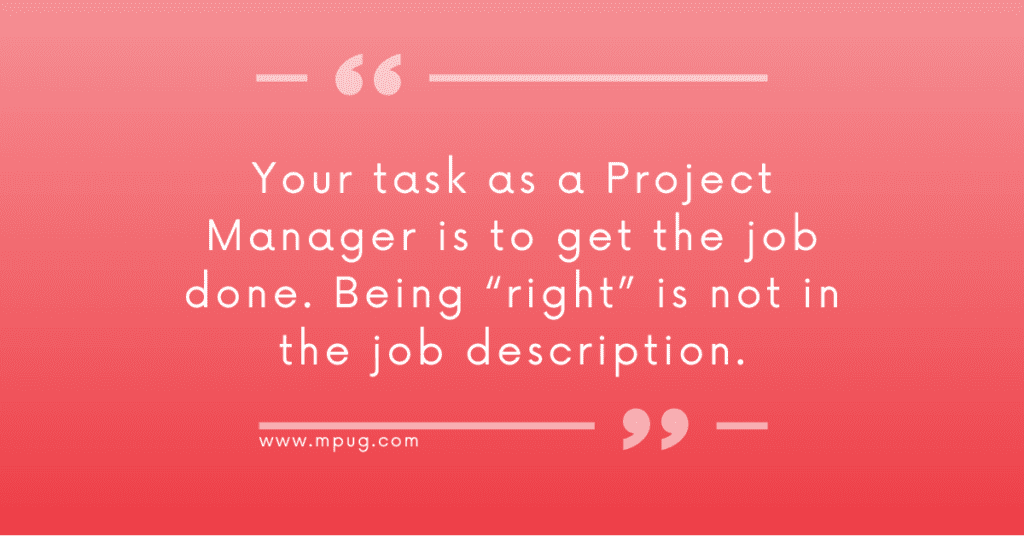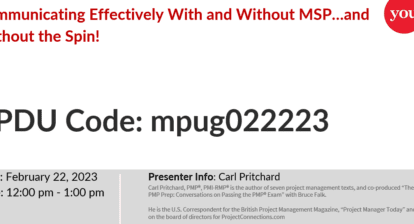
Is it any wonder we have conflicts on projects? After all, we have a team of people trying to do something difficult, under the pressures of time and budget, with other people offering everything from helpful advice to criticism and outright resistance.
So, in a very real sense, dealing with conflict is a part of the Project Manager’s job description. And, if that’s not what you thought you signed up for, then you’d better get good at spotting the warning signs early and de-escalating it quickly.
Conflict is like an arch. It goes up one side and comes down the other. But only if there’s a keystone in place to spread the load. De-escalation is all about getting that keystone in place and turning the arch over.
In this article, we’ll look at why conflict can start and then escalate on a project. Then we’ll consider some of the practical strategies for how to de-escalate.
The Little Triggers: Reasons for Conflict
Conflict has an infinite number of causes. If you have any experience in life, you will already know this. So, to understand the sources of conflict, we need to categorize them. In my experience, in projects, conflict often arises in four contexts.
Conflict arises over:
- The projects, work packages, or tasks we need to do
- How we can best get them done
- The relationships among the people we work with
- Personal agendas, petty politics, and culture clashes in our organizations
These all operate on people’s assessments of – and disagreements about – what’s right, what’s necessary, and what’s best. And, of course, if you don’t agree with me, there’s the potential for conflict. As soon as one of us thinks respect has broken down, or we have something to fear…look out!
Causes and Triggers
Conflict is rarely started by the causes themselves. It’s usually something smaller that triggers it. But here is the important thing to know if you want to minimize conflict in and around your project: people won’t notice the triggers, if the causes are either not there, or are not potent enough.
So, your primary conflict management strategy must be to:
- Scan the environment for potential causes of conflict
- Expose them and discuss them openly
- Deal with the underlying issues in a timely way
Think of them as the time bomb in your favorite children’s cartoon. If the characters can diffuse it early, nothing bad will happen. This is why so many Project Managers will tell you that 80% of Project Management is communication. You need to be in constant communication with team members and stakeholders to spot and handle these potential causes of conflict.
Rising Tensions: Conflict Escalation
Conflict escalates through a series of familiar stages. Each one seems little more than the last, but the cumulative effect has the potential for danger:
- Toleration becomes irritation
- Irritation leads to challenge
- Challenge provokes anger
- Anger can become abuse
- Abuse can escalate to violence
And it always seems to me that this is like an exponential curve. The further up this escalation arch we go, the faster things seem to happen. A little irritation does not feel much worse than toleration. But violence…that’s a lot worse than abuse.
So, there’s another reason to spot the signs and act early.
The Signs of Conflict Escalation
We can see the signs of rising conflict in the body language of the people in conflict. Indeed, we can see the tension in any people around them too. There tend to be four components to notice:
Posture
As people start to feel irritation, they either:
- Lean away to try to move away from the source of conflict and ease their discomfort, or
- Lean in, to signal confrontation and escalate it
This is a good indicator (though not 100% reliable) of whether each of the parties is keen to escalate or de-escalate. If both lean back, de-escalation should be straightforward, if you can find the right formula. If both lean in, even the right formula may not help. These two want a fight, and the trigger is almost completely incidental.
Gesture
The first gestures you see will betray doubts about conflict, or disbelief that it’s happening. These include:
- Face-touching, indicating confusion and doubt
- Eye-blocking, which says “I don’t want to see this” – a sign of disagreement or conflict avoidance
Later gestures allay our feelings of anxiety and insecurity. These include, in order of escalating discomfort:
- Fidgeting or fiddling with an object
- Playing with cuffs, watch, or bracelet
- Fiddling with a tie or collar (for men) or a necklace or scarf (for women)
- Touching the neck
- Rubbing hands along our thighs (pretty extreme anxiety)
Expression
Facial expressions also change during conflict. Look out for early signs of anger or disgust. You’ll first see nose wrinkles, pursed lips, and the forehead start to furrow. These indicate reactions to the other person and the stress we feel from the situation.
Vocalization
Finally – and maybe not strictly body language – the way we speak changes. The fast, shallow breathing of fear gives the voice a breathy quality. And the constriction of neck muscles from anger or desperation can give the voice a “strangled” higher pitched sound. You may also hear more throat-clearing as the fight-or-flight reflex supresses saliva production.

The Keystone: Choosing to Engage
The keystone to conflict management is a positive decision to engage with the other person in a respectful way, to de-escalate the conflict, and deal with the issue at its heart. This means two things:
- At the minimum, the proximate trigger, which you need to resolve, to make progress
- Ideally, the underlying causes that would otherwise remain in waiting for the next triggering event
This takes self-awareness. You have to:
- Recognize you are in conflict
- Want to resolve it more than you want to “win”
- Be prepared to lose face
- Value the outcome and the relationship more than being seen as “right”
If you can do this, then what next?
De-escalation: The Stages for Resolving Conflict
The first thing you need to do is to reach out to the other person with the message that you want to fix the conflict, rather than engage in it, and to invite them to do the same. If they agree, then you will have temporarily halted the conflict, to give yourself time to start to resolve it.
Build rapport through openness, honesty, and appreciation of the steps the other person is taking to do the same. Your priority here is not to persuade them that you are somehow “right” but to listen hard and understand their perspective, by seeing things from their point of view.
Now you can work together to develop criteria for a new way of working together to resolve your dispute. Once you have them, you can discuss options for how each of you will act. Evaluate those against your criteria, and then step forward one last time, to make a commitment to the other person that you can – and fully intend – to honor. If you have de-escalated effectively, they are likely to reciprocate with their own offer of a commitment.
[For more on the escalation and de-escalation of conflict: https://youtu.be/2r6KsXD1mwk]
Practical Lessons: Conflict Management Techniques for Project Management
If you want one technique, above all that will help you resolve conflict after it arises, my answer is simple. So, let’s start there.
The First Technique
The technique is to shut up and listen. Give your full attention to the other person and really hear what they have to say. Don’t interrupt, don’t reply, and don’t defend your position. Just signal your understanding and ask questions to clarify and to learn more.
William James said it best: ‘The most important need of the human soul is to be understood’.
But the most practical guidance comes from Stephen Covey: “Seek first to understand, then to be understood.” Until you understand the other person, you don’t have a basis to be understood.
After this, the next most important technique is to know what strategy to take.

Choose Your Investment
People too often assume that we always need a “win-win” outcome to every conflict. That is, both parties come away happy, having gained from the process. It’s a lovely ideal, pedalled by some so-called management gurus.
But, in the real world, it is nonsense. Building a true collaborative outcome from every conflict would take too much work, and some disputes are simply not worth it. That’s not to say you should be encouraging – or even allowing – conflict in all your interactions. But, if you do find yourself in conflict, maybe another strategy is right at the time.
It’s easier – and often good enough – to find a compromise. Neither of you feel great about the outcome, but equally, neither feels that they have lost out more than the other person. A compromise is a fair outcome where both parties give up an acceptable and equal amount. This can be something material, like a sense of “correctness,” pride, or time, for example.
And don’t forget, some conflicts are not worth the candle. Just walk away. Let the other person have what they want because it simply doesn’t matter enough. Don’t waste your emotional energy. However, when you do this, do it with grace. No snide or sarcastic remarks. No grudging “I suppose so.” Just a full-throated “yes, you’re right.”
Remember, your task as a Project Manager is to get the job done. Being “right” is not in the job description. That’s just a bonus that strokes your ego, but serves no purpose for your organization, your sponsor, or your client. Let go.
And, if you can shed your need to be right, just a few times a week, imagine how much less conflict you’ll have. And how much more pleasant your week will be!
Related Content
What Type of Conflict Do You Have In Your Workplace?






